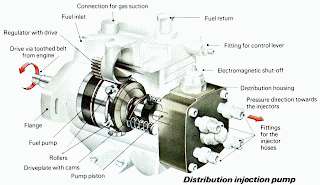how a engine lubrication system functions and talks about the main components for lubricating an engine (oil pump, oil filter, oil store, oil splash, etc
Functions of oil
Oil reduces unwanted friction. It reduces wear on moving parts, and helps cool an engine. It also absorbs shock loads and acts as a cleaning agent.
Viscosity
Viscosity rating indicates flow rate of oil at a given temperature. There are many grades. Thin oils tend to be for cold conditions. Oil with improver is called multi-grade or multiple-viscosity oil.
Oil additives
Different additives do different jobs. They can inhibit corrosion, foaming and oxidation, and act as dispersants.
Synthetic oils
Synthetic oils offer better protection against engine wear and can operate at higher temperatures. They have better low temperature viscosity, are chemically more stable and allow for closer tolerances in engine components without loss of lubrication.
Lubrication systems
The lubrication system
The lubrication system is designed to keep the components in the engine lubricated and to reduce friction.
Splash system
In the splash lubrication system, a dipper or slinger splashes oil through the internal parts of the engine. Oil is also splashed up to the valve mechanism.
Pressure system
In force-feed lubrication, pressure forces oil around the engine. In a wet-sump system, oil is kept in the sump ready for the next use. In a dry sump system, oil falls to the bottom of the engine and a scavenge pump sends it to an oil tank.
2-stroke engine premix fuel systems
Most 2-stroke gasoline engines use a set gasoline-oil mixture for lubrication. As the air, fuel and oil enter the crankcase, the fuel evaporates, leaving behind enough oil to keep parts coated and lubricated.
2-stroke engine oil injection systems
An oil injection system doesn't need the oil and gasoline mixed manually. An engine-driven oil pump takes oil from a tank and pumps a measured amount directly into the engine where it mixes with the fuel and lubricates the internal engine parts.
Rotary engine lubrication system
In addition to normal internal lubrication, the rotary engine uses oil injection. A pump injects a measured amount into the intake manifold. Oil from these nozzles goes to the engine and lubricates the rotor seals.
Corrosion/noise reduction
Engine oil performs many other functions apart from lubricating moving components. Two other functions are corrosion protection and noise suppression.
Lubrication system components
Sump
The sump is at the base of an engine. It can be used as a storage container in a 'wet sump system'.
Oil collection pan
An oil collection pan is used in 'dry sump systems' prior to being returned to an oil tank.
Oil tank
The oil tank is part of the dry sump lubrication system and is used for oil storage.
Pickup tube
A pickup tube is used to provide a means of collecting oil for the oil pump.
Oil pump
Oil pumps deliver oil under pressure to the internal engine parts. In a rotor-type oil pump, an inner rotor drives an outer one. Pressure differences force the oil to move. Geared oil pumps use a similar principle.
Oil pressure relief valve
The pressure relief valve is used to prevent damage to an engine due to too much oil pressure.
Oil filters
The oil filter helps to clean the oil in the system. If the filter clogs, a valve opens and directs unfiltered oil to the engine. Most oil-filters on diesel engines are larger than those on similar gasoline engines.
Spurt holes & galleries
Spurt holes and galleries are used to deliver oil from the oil pump to various components and bearings in the engine.
Oil indicators
Oil indicators are used to check when there are safe oil levels in an engine.
Oil cooler
An oil cooler cools oil prior to its reuse in the engine.
Lubrication procedures
Checking engine oil
The objective of this procedure is to show you how to check and adjust engine oil level and condition. Make sure the vehicle is on a level surface and the engine is off before taking a reading. If you don't, you'll get inaccurate readings.
Draining engine oil
Oil loses its clean, fresh look very quickly and yet may still be serviceable. The best guide to changing oil is knowing the vehicle's mileage and period of time since the last oil change. The objective of this procedure is to show you how to safely drain engine oil.
Replacing an oil filter
The objective of this procedure is to show you how to replace an oil filter to the manufacturer's specifications. Before removing an oil filter, first refer to the Service Manual for the vehicle and identify the type of filter required.
Refilling engine oil
The objective of this procedure is to show you how to safely refill engine oil. The service manual or the owner's manual will also tell you the correct grade of oil for the vehicle, and the quantity you will need to fill the engine.



















